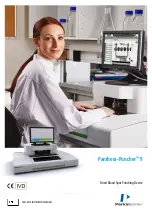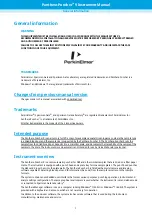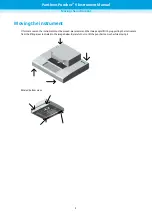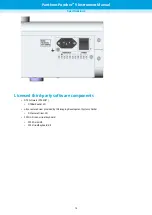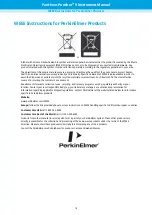
Functional description
The Panthera-Puncher 9 consists of:
• two main modules
• the plate track
• the punch head
• three functional units
• the camera
• the punching platform
• the touch screen.
The plate track
The plate track consists of the plate tray and the mechanics that move it. The plate tray can hold up to 9 plates
simultaneously, of which a maximum of 3 plates can be deep well microtiter plates. When required, the instrument will
bring out the plate tray so that the user can load plates in all positions simultaneously. When all the plates have been
loaded, the instrument brings the tray back inside and starts to read barcodes from the plates that are present. If no
plate is present, the instrument will know that position is empty.
During the punching operations, the plate track moves in such a way that the target well is placed under the punch
head. Once it is positioned, the instrument punches the disk, which falls into its assigned well.
The punch head module
The punch head module consists of the punch head mover and the punch head itself. The punch head makes the
punching movement that cuts the disk from the sample card. The punch head mover is responsible for two actions: it
can switch between two punch heads of different sizes, and it brings the punch head to the exact location where the
disk needs to be punched. The instrument can contain 2 punch heads at the same time, and these can be of 5 different
sizes: 1.5, 3.2, 3.8, 4.7 and 6 mm.
The camera
The CCD camera is located above the punching platform. It provides the image used to display the sample card on
the screen. The software analyses the sample card image and allows real time blood detection. Together with the
intelligent punching location algorithm, it offers great benefits to the users: the sample card blood spot is used in the
most efficient way. The camera is also able to read the barcode of the sample card in the punching area. For Quality
Assurance (QA) purposes, the system can also save the camera blood card image every time the punch command has
been given. The blood card image will include the dots indicating the planned punches, their numbers and the image
meta-data will contain the assay information. The default folder for storing these pictures is c:/users/public/public
documents/Panthera, and it can be accessed easily from the Documents library shortcut in the Windows file explorer.
The pictures are organized by date with the Panthera folder containing one sub-folder for each year. Each year folder
contains one sub-folder for each month, and each month folder contains one sub-folder for each day. Each blood
card image file name contains the card barcode (or ID) and a timestamp. The file metadata holds information on the
punches, i.e. which disk was punched into which well of which plate.
The punching platform
The punching platform not only provides the support for the sample card while punching, but it also helps the software
detect a sample card thanks to 4 "hot spots" on the dark background. When some of these hot spots' color intensity
changes, it means that a card has been placed in the punching area. The punching area is also equipped with sensors
and the gripper. The sensors enable the user to trigger the punching operation by tapping the platform. The gripper
holds the card in place during punching.
Panthera-Puncher
™
9 Instrument Manual
Functional description
6
Содержание 2081-0010
Страница 1: ...2081 0010 INSTRUMENT MANUAL Panthera Puncher 9 Dried Blood Spot Punching Device ...
Страница 2: ......
Страница 4: ...WEEE Instructions for PerkinElmer Products 14 Warranty 15 Index 17 ii ...
Страница 20: ...Panthera Puncher 9 Instrument Manual Warranty 16 ...
Страница 22: ...18 ...
Страница 23: ......

